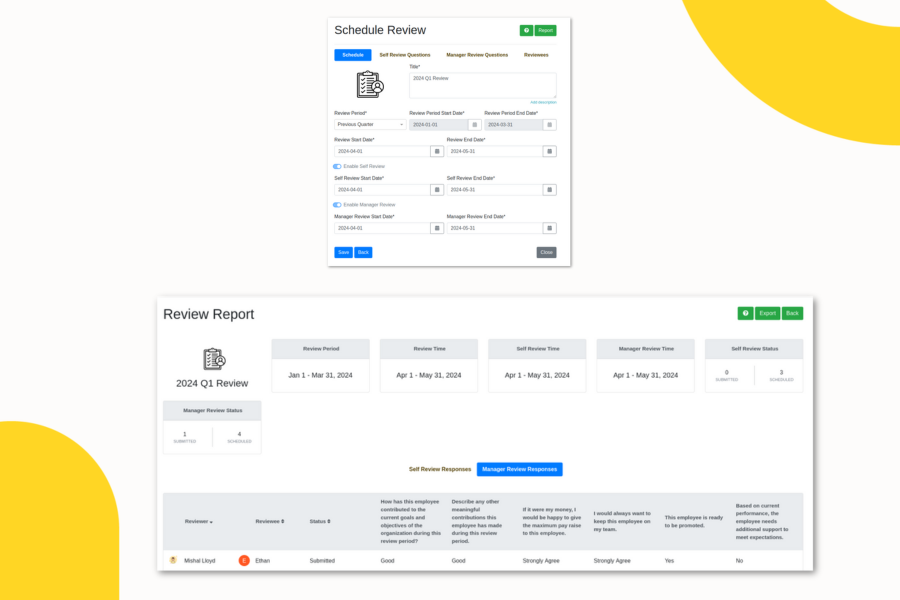Periodic Reviews: The Agile Way of Doing Performance Reviews
In traditional performance management, organizations mostly rely on annual or semi-annual reviews to assess employee performance. This involves managers rating their employees over their past performance, discussing the next set of goals, and sometimes making decisions on compensation and promotion. While traditional performance reviews meet their end goals, they are often inadequate for our times; their main drawbacks being:
- Infrequent: Traditional performance reviews provide feedback too infrequently to drive meaningful change.
- Backward-looking: They focus mainly on past performance rather than future potential.
- Recency bias: Managers tend to emphasize recent events over those from earlier in the review period.
- Time consuming: The process often requires significant preparation time for both managers and employees.
- Stressful: The performance rating exercise is often stress inducing for both managers and employees.
What are Periodic Reviews?
Periodic reviews are a radical departure from the traditional review process. They represent a shift towards more frequent, forward-looking, and actionable evaluation of performance. Unlike their annual counterparts, periodic reviews are designed to capture up-to-date data on employee performance and potential, providing a more accurate picture of employee’s contributions and improvement areas.
The key differences between traditional performance reviews and agile periodic reviews include:
- Frequency: While traditional reviews happen annually or semi-annually, periodic reviews occur multiple times throughout the year, often quarterly or even monthly.
- Forward-looking: Traditional reviews look back at past performance; periodic reviews emphasize current performance and future potential.
- Format: Traditional reviews often involve lengthy forms and meetings; periodic reviews are brief, focused assessments.
- Purpose: Traditional reviews often focus on rating employee’s past performance; periodic reviews aim to provide ongoing feedback and guide development.
- Continuous: Traditional reviews are typically once or twice a year exercises; periodic reviews are designed to be an integral part of ongoing performance management.

Benefits of Periodic Reviews
Periodic reviews represent a significant leap forward in the realm of performance management. By providing frequent, forward-looking assessments, they enable organizations to nurture talent more effectively and respond more nimbly to changing business demands:
- Increased accuracy: By capturing performance data more frequently, periodic reviews provide a more accurate picture of an employee’s contributions over time.
- Reduced recency bias: Periodic reviews mitigate the tendency to focus only on recent events, a common pitfall of annual reviews.
- Improved agility: Quick assessments allow organizations to respond more rapidly to changing performance trends.
- Employee development: Frequent feedback enables preparation of more timely and targeted development plans.
- Better decision making: Availability of up-to-date performance data supports more informed decisions about compensation and promotion.

The Anatomy of Periodic Reviews
A typical periodic review consists of a few key questions that managers answer about their team members. These questions are carefully crafted to elicit meaningful insights without being overly time-consuming. For example, Deloitte, a pioneer in this approach, uses four critical questions:
- Would the manager award this person the highest possible compensation increase and bonus?
- Would the manager always want this person on their team?
- Is this person at risk for low performance?
- Is this person ready for promotion today?
The effectiveness of these questions lies in their simplicity in capturing a holistic view of an employee’s current status and future potential. Netflix also follows a similar strategy in building their high performance culture.
Integration with Agile Performance Management
Periodic reviews are not standalone tools but integral components of a broader agile performance management process. They work in congruence with other elements such as:
- Agile goal-setting: Ongoing processes to ensure individual goals and objectives align with those of the team and the organization.
- Regular check-in meetings: Frequent one-on-one (1:1) meetings between managers and employees to discuss progress and challenges.
- Ongoing feedback: Mechanisms for providing immediate praise or constructive criticism outside of formal review processes.
By integrating periodic reviews with these other elements, organizations can create a comprehensive system that supports continuous improvement and agile talent management.

Periodic Reviews in Peptrics
Periodic reviews revolutionize how you measure and improve employee performance over time. You can finally ditch the dreaded annual reviews in favor of lightweight, continuous performance assessments. Peptrics’ agile performance management solution takes periodic reviews one step further to include self assessments into the review process, creating a more holistic view of each employee’s contributions and capabilities. Peptrics is designed to seamlessly integrate periodic reviews into your organization’s performance management workflow:
- Schedule reviews with customizable review and submission periods
- Facilitate time-bound self reviews and manager reviews
- Support multi-level reviewers
- Leverage configurable review questionnaires
- Automate reminders for review submission
Don’t let outdated performance management practices hold your organization back. Embrace the future of performance management with Peptrics and unlock the full potential of your workforce. To learn more about how Peptrics can transform your performance management processes and drive organizational success, sign up for a free account today.
